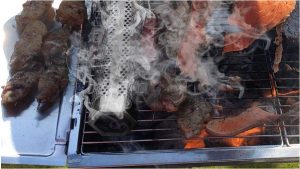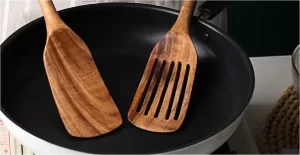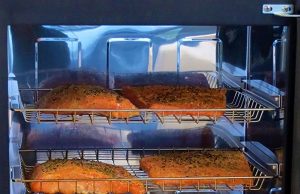Do You Have to Soak Wood Chips for Smoker? Know the Reality
If you’re an avid smoker, you may have wondered whether soaking your wood chips is necessary. Contrary to popular belief, soaking wood chips before smoking meat isn’t necessary and can actually have a negative impact on the flavor of your meat.
Instead, using dry wood chips and letting them ignite naturally is the best way to create a thin, blue smoke that is perfect for smoking meats. This holds for both traditional and electric smokers. If you prefer wood chunks instead of chips, you don’t necessarily have to soak them either.
Choosing the right type of wood for your meat and controlling the temperature and smoke level are key factors in achieving the perfect smoke flavor. So next time you fire up your smoker, skip the soaking and go straight for the dry wood chips.
What Happens When You Soak Wood Chips?
Many people believe that soaking wood chips before adding them to your smoker can help them burn more slowly and create more smoke. The science behind soaking wood chips tells a different story.
When you soak wood chips, water penetrates the outer layer of the wood and fills the pores. This makes the wood less flammable and slows down the rate at which it burns.
However, it also makes the wood produce more steam than smoke, which can affect the flavor of your meat.
Reasons to Soak Wood Chips
One of the main reasons people soak wood chips is because of tradition or personal preference. They may have learned to do it that way from someone else, or they may simply prefer the way the smoke tastes when using soaked wood chips.
Also, some people may have read or been told that soaking wood chips can help prevent them from burning up too quickly, which could be beneficial for longer smoking sessions.

Why Soaking Wood Chips Isn’t Necessary?
Soaking wood chips is a common misconception that has been perpetuated for years. Many people believe that soaking wood chips before smoking will prevent them from catching fire and producing too much smoke. However, this is not the case. Soaking wood chips can actually cause more problems than it solves.
When you soak wood chips, you are essentially adding water to the mix. This water will take longer to heat up than the dry wood chips, which means that it will take longer for the chips to start smoking. This can cause the temperature in your smoker to drop, which can result in uneven cooking and a longer smoking time.
Another issue with soaking wood chips is that it can actually create more smoke than you want. When the wet wood chips hit the hot coals or heating element, they will produce steam. This steam will mix with the smoke and create a thick white smoke that can overtake the meat and give it an unpleasant flavor.
Using dry wood chips, on the other hand, will produce a thin, blue smoke that is perfect for smoking meats. Dry wood chips will ignite naturally and produce smoke quickly, which means that you can get your smoker up to temperature faster and start smoking your meat sooner.
It is also important to note that soaking wood chunks is not necessary either. Like wood chips, dry wood chunks will produce the perfect smoke for your meat without the need for soaking. The key is to choose the right type of wood for your meat and control the temperature and smoke level in your smoker.
Using Dry Wood Chips
If you decide to use dry wood chips, it’s important to choose the right ones for your meat. Different types of wood produce different flavors, so experiment with different varieties to find the one that best complements your meat. Some good options include hickory, applewood, cherry, and mesquite.
When using dry wood chips, you can add them directly to the smoker without soaking them first. Simply add a handful of chips to the coals or smoker box, and let them ignite naturally. This will create a thin, blue smoke that is perfect for smoking meats.
It’s important to note that you should not use too many wood chips at once, as this can cause a thick, white smoke that can be harmful to the flavor of your meat. Start with a small amount and add more as needed.
Tips for Achieving Great Smoke Flavor
1. Choose the Right Wood
The type of wood used in smoking plays a significant role in the flavor of the finished product. Different woods have unique flavors and aromas, and some pair better with certain meats than others.
For example, applewood is a popular choice for smoking pork, while hickory is often used for beef. Make sure to research the best woods for the meat you plan to smoke and experiment with different combinations to find your favorite flavor profile.
2. Use the Right Amount of Smoke
Using too much smoke can overpower the meat and make it taste bitter while using too little can result in a lack of flavor. A good rule of thumb is to smoke the meat for no more than half of the total cooking time and to use only a handful of wood chips at a time.
It’s also important to ensure good ventilation in your smoker to avoid excess smoke buildup.
3. Control the Temperature
Temperature control is essential for achieving great smoke flavor. Smoking meat low and slow allows it to absorb more smoke and results in a tender, juicy finished product.
Aim for a temperature between 225-250°F for most meats, and use a thermometer to monitor the internal temperature of the meat as it cooks.
4. Prep the Meat
Prepping the meat properly before smoking can also enhance the flavor. Applying a dry rub or marinade can infuse the meat with additional flavors while allowing it to come to room temperature before smoking can help it cook more evenly.
Some people also choose to inject their meat with a flavorful liquid to add moisture and depth of flavor.
5. Rest the Meat
Allowing the meat to rest for a few minutes after smoking can make a big difference in the final flavor. This allows the juices to redistribute throughout the meat, resulting in a more tender and flavorful finished product.
Cover the meat loosely with foil and let it rest for at least 10-15 minutes before slicing and serving.
Learn More: Do You Need To Put Water In A Smoker?
Best Wood Chips for Smokers
Selecting the right wood chips for your smoker can greatly enhance the flavor of your smoked dishes. There are various types of wood chips available, each imparting a unique flavor profile to the food.
Some popular options include hickory, mesquite, apple, cherry, and oak. Hickory and mesquite provide a strong, bold flavor, while fruitwoods like apple and cherry offer a milder, sweeter taste.
Oak is a versatile choice, imparting a medium-intensity flavor that complements a wide range of foods.
1. Wood Chips for Smoker Box
A smoker box is a handy accessory that allows you to use wood chips on a gas or charcoal grill. To ensure optimal results, choose wood chips that are compatible with your smoker box and the food you’re cooking.
2. Wood Chips for Smoking Meat
The art of smoking involves using wood chips to infuse food with a rich, smoky flavor. Different wood chips impart distinct flavors, so it’s essential to choose the right type for your desired outcome.
For example, hickory and mesquite are ideal for smoking beef and game meats, while fruitwoods like apple and cherry are better suited for poultry and fish. Alder is a popular choice for smoking seafood, as it imparts a delicate, mild flavor.
3. Wood Chips for Smoking Turkey
Smoking a turkey can result in a moist, flavorful bird with beautiful, golden-brown skin. To achieve the best results, opt for wood chips that complement the natural flavors of turkey.
Fruitwoods like apple, cherry, and peach are excellent choices, as they provide a subtle, sweet smokiness that enhances the turkey’s taste without overpowering it. Mixing fruitwood with mild hardwood like oak can also yield delicious results.
4. Wood Chips for Smoking Chicken
Chicken is a versatile protein that pairs well with various wood chip flavors. For a mild, fruity taste, use apple or cherry wood chips.
If you prefer a stronger, more robust flavor, hickory or mesquite can be a good choice. Experiment with different combinations of wood chips to find the perfect balance of smokiness and flavor for your smoked chicken dishes.
5. Wood Chips for Smoking Pork
Pork is a popular choice for smoking, and the right wood chips can elevate the flavor of your smoked pork dishes. Hickory is a classic option, imparting a strong, bacon-like flavor that pairs well with pork.
For a milder, sweeter taste, try using apple or maple wood chips. Mixing different wood chip varieties can also create unique flavor profiles that complement the natural taste of pork.
6. Wood Chips for Smoking Ribs
Smoked ribs are a barbecue favorite, and the choice of wood chips can greatly impact their flavor. Hickory and mesquite are popular options for smoking ribs, as they provide a bold, intense smokiness that complements the rich taste of the meat.
For a milder, sweeter flavor, consider using fruitwoods like apple, cherry, or peach. Experiment with different wood chip combinations to find the perfect flavor profile for your smoked ribs.
7. Wood Chips for Smoking Salmon
Salmon is a delicious and healthy protein that can be enhanced with the right wood chips. Alder is a traditional choice for smoking salmon, as it imparts a delicate, mild flavor that complements the fish’s natural taste.
Other options include apple, cherry, and maple, which provide a subtle, sweet smokiness. Avoid using strong-flavored wood chips like hickory or mesquite, as they can overpower the salmon’s flavor.
8. Wood Chips for Smoking Brisket
Brisket is a popular cut for smoking, and the choice of wood chips can greatly influence its flavor.
Oak is a classic option, providing a medium-intensity smokiness that complements the rich taste of brisket. For a bolder flavor, try using hickory or mesquite.
Fruitwood like apple and cherry can also be used for a milder, sweeter taste. Experiment with different wood chip combinations to find the perfect flavor profile for your smoked brisket.
9. Wood Chips for Smoking Fish
Fish is a delicate protein that can be easily overpowered by strong-flavored wood chips. For the best results, opt for mild, subtle wood chips like alder, apple, or cherry. These options provide a gentle smokiness that enhances the fish’s natural flavor without overwhelming it.
Avoid using strong-flavored wood chips like hickory or mesquite, as they can overpower the delicate taste of the fish.
FAQs
Will dry wood chips burn faster than soaked wood chips?
Dry wood chips will burn faster than soaked wood chips, but this is not necessarily a bad thing. The goal when smoking meat is to create smoke, not necessarily fire. Using dry wood chips allows you to control the smoke level more easily and achieve the perfect smoke flavor.
Do I need to soak wood chips if I’m using an electric smoker?
No, you do not need to soak wood chips if you’re using an electric smoker. Using dry wood chips is recommended for electric smokers, as it allows you to control the temperature and smoke level more easily.
Can I soak wood chips for a short amount of time?
Soaking wood chips for a short amount of time is not recommended, as it may not have any noticeable effect on the burning or smoking process. It’s best to either soak them for a longer period of time or use dry wood chips.
What’s the best way to store wood chips?
The best way to store wood chips is in an airtight container, such as a zip-top bag or plastic container. Store them in a cool, dry place to ensure they don’t absorb moisture.
Can I use wood chunks instead of wood chips?
Yes, you can use wood chunks instead of wood chips. Wood chunks will burn slower and produce more smoke than wood chips, so adjust the amount accordingly. It’s also important to choose the right type of wood chunks for your meat to ensure that the flavor complements the meat.
Conclusion
Soaking wood chips before smoking meat is not necessary and can actually have a negative impact on the flavor of your meat. Using dry wood chips and letting them ignite naturally is the best way to create a thin, blue smoke that is perfect for smoking meats. With the right wood chips, temperature control, and seasoning, you can achieve the perfect smoke flavor for your meats every time.





